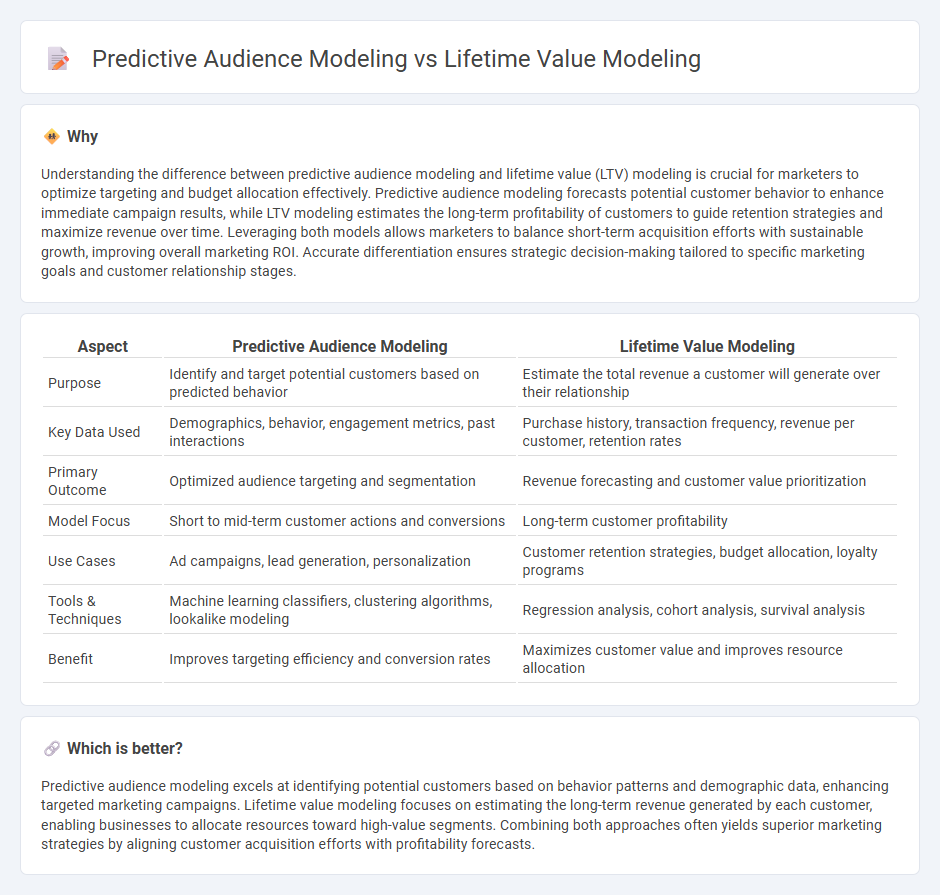
Predictive audience modeling leverages machine learning algorithms to identify and segment potential customers based on behaviors, interests, and demographics, enabling targeted marketing campaigns with higher conversion rates. Lifetime value (LTV) modeling calculates the projected revenue a customer will generate over their entire relationship with a brand, helping businesses allocate resources to retain high-value customers and maximize profitability. Explore deeper insights into how these models transform marketing strategies and boost ROI.
Why it is important
Understanding the difference between predictive audience modeling and lifetime value (LTV) modeling is crucial for marketers to optimize targeting and budget allocation effectively. Predictive audience modeling forecasts potential customer behavior to enhance immediate campaign results, while LTV modeling estimates the long-term profitability of customers to guide retention strategies and maximize revenue over time. Leveraging both models allows marketers to balance short-term acquisition efforts with sustainable growth, improving overall marketing ROI. Accurate differentiation ensures strategic decision-making tailored to specific marketing goals and customer relationship stages.
Comparison Table
| Aspect | Predictive Audience Modeling | Lifetime Value Modeling |
|---|---|---|
| Purpose | Identify and target potential customers based on predicted behavior | Estimate the total revenue a customer will generate over their relationship |
| Key Data Used | Demographics, behavior, engagement metrics, past interactions | Purchase history, transaction frequency, revenue per customer, retention rates |
| Primary Outcome | Optimized audience targeting and segmentation | Revenue forecasting and customer value prioritization |
| Model Focus | Short to mid-term customer actions and conversions | Long-term customer profitability |
| Use Cases | Ad campaigns, lead generation, personalization | Customer retention strategies, budget allocation, loyalty programs |
| Tools & Techniques | Machine learning classifiers, clustering algorithms, lookalike modeling | Regression analysis, cohort analysis, survival analysis |
| Benefit | Improves targeting efficiency and conversion rates | Maximizes customer value and improves resource allocation |
Which is better?
Predictive audience modeling excels at identifying potential customers based on behavior patterns and demographic data, enhancing targeted marketing campaigns. Lifetime value modeling focuses on estimating the long-term revenue generated by each customer, enabling businesses to allocate resources toward high-value segments. Combining both approaches often yields superior marketing strategies by aligning customer acquisition efforts with profitability forecasts.
Connection
Predictive audience modeling leverages historical customer data and machine learning algorithms to identify potential high-value segments, while lifetime value (LTV) modeling quantifies the expected revenue generated from these segments over time. Integrating predictive audience insights with LTV modeling enables marketers to prioritize acquisition and retention strategies focused on customers with the highest profitability. This connection enhances budget allocation efficiency and drives long-term revenue growth through targeted marketing campaigns.
Key Terms
**Lifetime Value Modeling:**
Lifetime value modeling estimates the total revenue a customer will generate over their entire relationship with a company, enabling businesses to allocate marketing resources efficiently and prioritize high-value segments. This model uses historical purchase data, customer behavior, and demographic attributes to forecast future value, enhancing customer retention strategies and personalized marketing efforts. Explore the benefits of lifetime value modeling to optimize your customer acquisition and retention programs.
Customer Retention
Lifetime value modeling estimates the total revenue a customer is expected to generate over their entire relationship with a business, enabling targeted retention strategies based on long-term value predictions. Predictive audience modeling uses behavioral and demographic data to identify segments most likely to respond to retention efforts, optimizing marketing resource allocation. Explore deeper insights to enhance customer retention through these advanced modeling techniques.
Churn Rate
Lifetime value modeling estimates the total revenue a customer will generate over their entire relationship, using churn rate as a critical factor to predict customer retention and future buying behavior. Predictive audience modeling utilizes churn rate data to identify and target segments with higher likelihood of attrition, enabling personalized retention strategies. Discover how integrating churn rate insights enhances both lifetime value and predictive audience models for maximizing customer loyalty.
Source and External Links
Customer Lifetime Value models - Oracle - The Customer Lifetime Value model estimates a customer's value over time using profile data and transaction patterns, and the model can be customized for different time horizons such as 3, 6, or 12 months, based on parameters including algorithm, queries, inputs, and outputs from the data model.
Customer lifetime value - Wikipedia - Customer Lifetime Value (CLV) is calculated as the present value of expected future margins from a customer, incorporating retention rate, margin per period, and discount rate, assuming a lifetime customer relationship with possible infinite horizon valuation.
What is lifetime value (LTV)? - Optimizely - Lifetime Value (LTV) estimates the average revenue generated by a customer during their lifetime and can be calculated differently depending on business models, such as dividing average revenue by churn rate for subscriptions or multiplying average order value by expected purchases and engagement time for non-subscription businesses.
 dowidth.com
dowidth.com